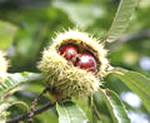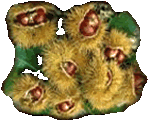Viña y Rosales Blog
name of author: Raul
Chestnuts (Castanea), including the chinkapins, are a genus of eight or nine species of trees and shrubs in the beech family Fagaceae, native to warm temperate regions of the Northern Hemisphere. The name also refers to the edible nuts produced by these trees. Most are large trees to 20-40 m tall, but some species (the chinkapins) are smaller, often shrubby. All are deciduous.

The leaves are simple, ovate or lanceolate, 10-30 cm long and 4-10 cm broad, with sharply pointed, widely-spaced teeth, with shallow rounded sinuses between. The flowers are catkins, produced in mid summer and have a heavy, unpleasant odour. The fruit is a spiny cupule 5-11 cm diameter, containing one to seven nuts. Chestnut trees thrive on acidic soils, such as soils derived from granite or schist, and do not grow well on alkaline soils such as limestone. When wanting to grow chestnut trees on such soils, the practice was to graft them onto oak rootstocks. Neither the horse chestnut (family Sapindaceae) nor the water chestnut (family Cyperaceae) is closely related to the chestnut, though both are so named for producing similar nuts.
Diseases: The American Chestnut, formerly one of the dominant trees of the eastern United States, has been almost wiped out by a fungal disease, chestnut blight, Cryphonectria parasitica. The American chinkapins are also very susceptible to chestnut blight. The European and west Asian Sweet Chestnut is susceptible, but less so than the American, and the east Asian species are resistant. These resistant species, particularly Japanese Chestnut and Chinese Chestnut but also Seguin's Chestnut and Henry's Chestnut, have been used in breeding programs in the US to create hybrids with the American Chestnut that are also disease resistant. Castanea species are used as food plants by the larvae of some Lepidoptera species; see list of Lepidoptera which feed on Castanea.
The sweet chestnut has the following scientific classification: Kingdom: Plantae - Division: Magnoliophyta - Class: Magnoliopsida - Order: Fagales - Family: Fagaceae - Genus: Castanea. The following species are known: - Castanea alnifolia - Bush Chinkapin (treated as a synonym of C. pumila by many authors); Castanea crenata - Japanese Chestnut; Castanea dentata - American Chestnut; Castanea henryi - Henry's Chestnut; Castanea mollissima - Chinese Chestnut; Castanea ozarkensis - Ozark Chinkapin; Castanea pumila - Allegheny Chinkapin; Castanea sativa - Sweet Chestnut; Castanea seguinii - Seguin's Chestnut (from Wikipedia)

Chestnuts should not be confused with Horse-chestnuts, which are used in the United Kingdom to play a game called conkers. Conkers, or Horse-chestnuts, are poisonous and are obtained from the tree of the same name.
Chestnut tree wood is similar to oak wood in being decorative and very durable. Due to disease, American Chestnut wood has almost disappeared from the market. It is difficult to obtain large size timber from the Sweet Chestnut, due to the high degree of splitting and warping when it dries. The wood of the Sweet Chestnut is most used in small items where durability is important, such as fencing and wooden outdoor cladding ('shingles') for buildings. In Italy, it is also used to make barrels used for aging balsamic vinegar.
The bark is also a useful source of natural tannins, in the past it was used for tanning leather before the introduction of synthetic tannins.
To preserve chestnuts through the winter, they must be made perfectly dry after they come out of their green husk; then put into a box or a barrel mixed with, and covered over by, fine and dry sand, three parts of sand to one part of chestnuts. Any maggots in any of the chestnuts will emerge and work up through the sand to get to the air without damaging other chestnuts. Chestnuts to be grown in the spring need to be kept in moist sand and chilled over the winter.
The nuts are an important food crop in southern Europe, southwestern and eastern Asia, and also in eastern North America before the chestnut blight. In southern Europe during the Middle Ages, whole forest-dwelling communities, which had scarce access to wheat flour, relied on chestnuts as their main source of carbohydrates. Chestnuts are very low on fat, have no cholesterol, gluten or oil.
The best chestnuts for roasting are the larger, better quality called "marroni". Only the rich brown, firm ones will do to produce sweet, soft, delicious roasted chestnuts. The regular "castagne" are best kept for boiling. The nuts can be eaten candied, boiled or roasted; the former are often sold under the French name marrons glacés. One easy method for roasting is to cut a slit in the top of each nut and heat it in a shallow container, tossing occasionally, at 200-220 °C for 10-15 minutes. Always score or make slits to break the tough skin along the rounded side of each chestnut before cooking. This promotes even cooking and to keeps them from popping during cooking.
When roasting the nuts you will know they are done when the skins have become quite black, but not charred. This usually takes 5 to 10 minutes, depending on how many chestnuts are in the pan or burner. The skin of roasted chestnuts hardens quickly and are even more difficult to break open when the roasted chestnuts are cooled. For the microwave, put a half dozen raw scored chestnuts on a dish, and cook them for about half a minute at full power. Hot chestnuts are really hot, so watch your fingers and your tongue. It only takes a few minutes for the marroni to become cool enough to enjoy their delicious meat. A good method is to crush chestnuts in a towel while they are still hot, so that their still-crispy skins will break. To make basic chestnut paste, shell the raw chestnuts, boil about 10 minutes, remove the remaining fur-like skin, and pass through a potato ricer (or use a food processor or stick blender). The fridge is the best place to store chestnuts before use (or freezer for longer-term storage).
Another important use of chestnuts is to be ground into flour, which can then be used to prepare bread, cakes and pasta.
Chestnut-based recipes and preparations are making a comeback in Italian cuisine, as part of the trend toward rediscovery of traditional dishes.